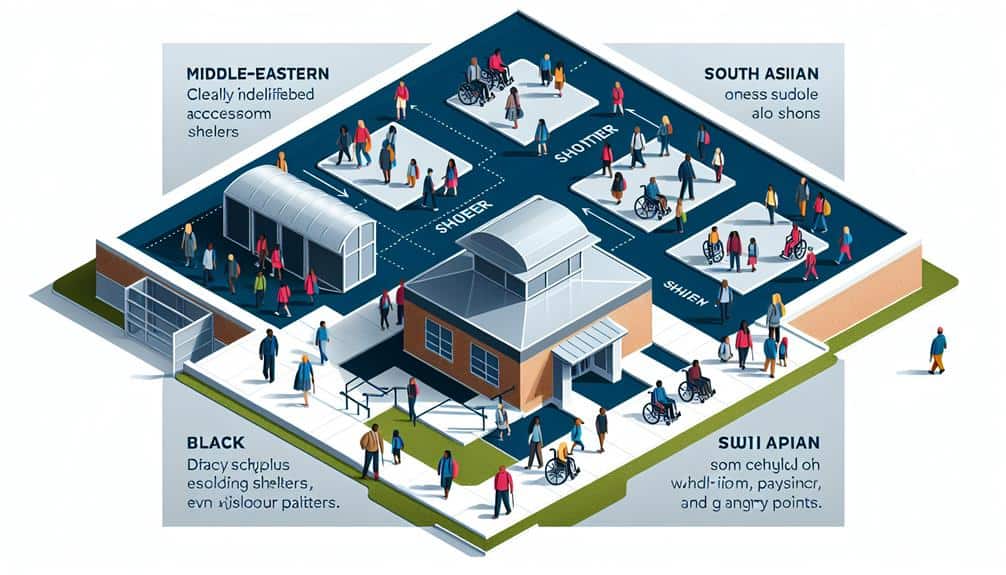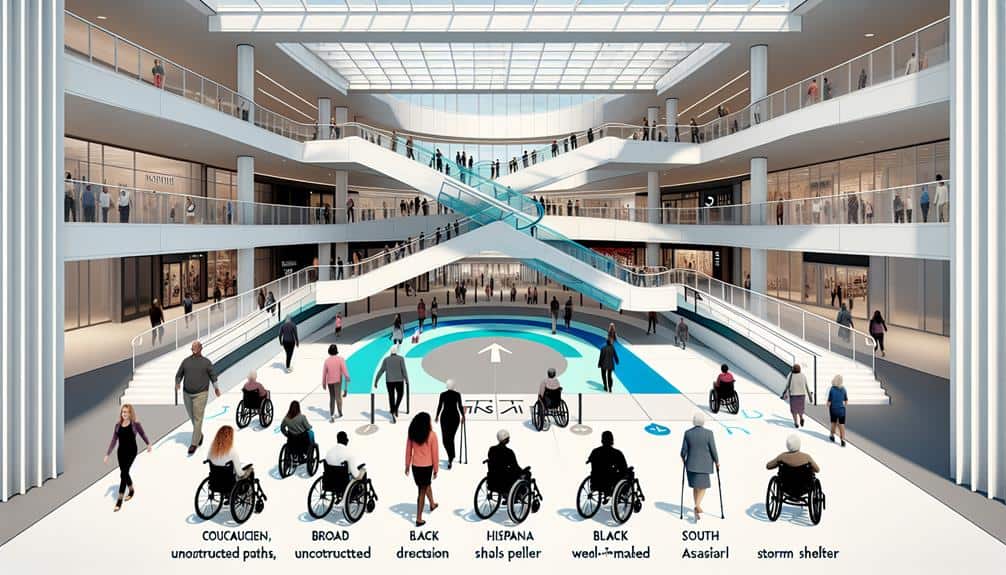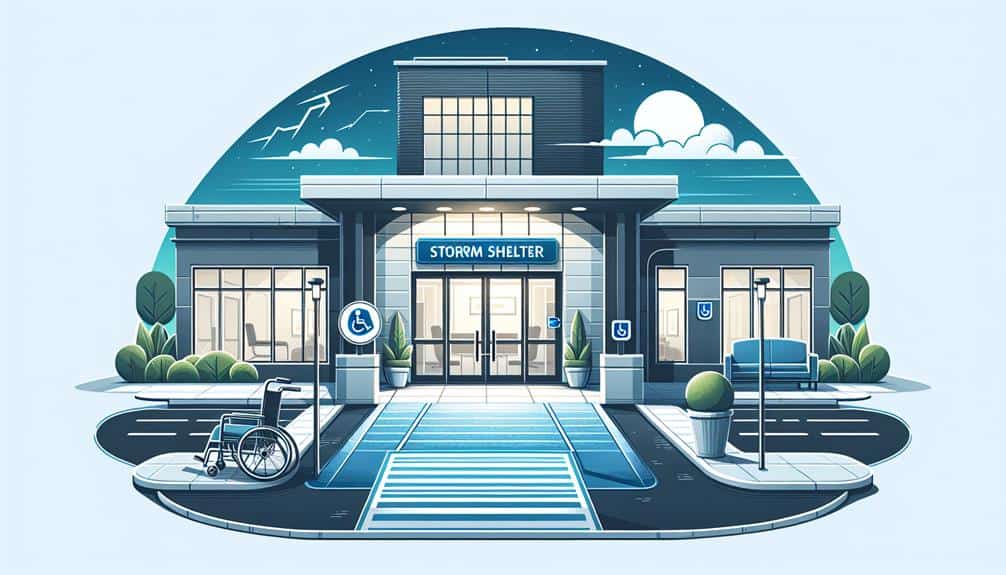Let's guarantee everyone stays safe and prepared during storms by knowing about accessible shelter locations for wheelchair users. Urban community centers designed for inclusivity, and public libraries with ramps and accessible restrooms, are great options. Schools and universities often have detailed, accessible maps and spacious pathways. Government buildings follow strict accessibility standards, while shopping malls and sports arenas feature ramps, elevators, and well-planned emergency procedures. Hospitals and clinics not only offer wide corridors and automatic doors but also have thorough evacuation plans. Discover more about these practical, inclusive options to keep all members of our community safe.
Key Points
- Urban community centers offer inclusive storm shelters with accessible amenities and well-trained personnel for personalized assistance.
- Public libraries provide ramp accessibility, wide doorways, and emergency preparedness plans tailored for wheelchair users.
- Schools and universities feature accessible entrances, clear signage, and detailed maps of storm shelters with accessible routes.
- Government buildings maintain strict accessibility standards, clear signage, and proximity to public parks.
Urban Community Centers
Urban community centers often serve as important hubs for accessible storm shelters, providing wheelchair users with safe and convenient refuge. These centers are typically designed with inclusivity in mind, guaranteeing that individuals of all abilities can access essential services during emergencies. Park facilities and recreational centers frequently double as storm shelters, offering ample space and necessary amenities, such as accessible restrooms and ramps, that cater to wheelchair users.
By utilizing urban community centers, we take advantage of existing infrastructures that are strategically located within our neighborhoods. These centers are usually near local businesses and restaurants, making it easier for us to grab essential supplies and meals before heading to the shelter. The proximity to these local amenities means we can maintain a semblance of normalcy even in emergency situations.
Moreover, community centers are often well-staffed with trained personnel ready to assist. This ensures that wheelchair users receive personalized help as needed, making the experience less challenging.
As we seek freedom and safety during storms, urban community centers stand out as practical and reliable options, offering not just shelter but a sense of community and support during challenging times.
Public Libraries
Let's turn our attention to public libraries, which often serve as crucial storm shelters.
We'll look at their accessibility features, how they incorporate emergency preparedness plans, and the community support programs they offer.
Accessibility Features Overview
Many public libraries have implemented a range of accessibility features to make sure that wheelchair users can safely and comfortably access storm shelters.
First and foremost, ramp accessibility is a key element. These ramps are designed with gentle slopes and non-slip surfaces to guarantee smooth and secure entry. They lead directly to shelter areas, minimizing any obstacles we might encounter.
Inside the shelters, amenities are carefully considered. Libraries often provide accessible restrooms, wide doorways, and ample space to maneuver. These features make it easier for us to navigate and settle comfortably during an emergency.
Additionally, emergency evacuation routes are clearly marked and tailored for wheelchair access, making sure that we can exit quickly and safely if needed.
Libraries also install automatic doors and low-threshold entrances. These practical features remove physical barriers, making it simpler for us to enter and leave without assistance.
During emergencies, staff are trained to assist wheelchair users, and they make sure that shelter amenities meet our needs.
Emergency Preparedness Plans
To safeguard our safety during emergencies, public libraries have developed extensive preparedness plans that include specific protocols for wheelchair users. First, they've established clear communication plans to make sure everyone knows what to do when a storm hits. These plans include accessible alerts and instructions, using multiple formats like text, email, and audible announcements to reach all patrons.
Next, libraries stock emergency supplies tailored for wheelchair users. These supplies include items like medical necessities, portable chargers for electric wheelchairs, and accessible first aid kits. This forethought guarantees that we've what we need right when we need it most.
Evacuation routes are another important component. Libraries have mapped out accessible routes that are free of obstacles and clearly marked, ensuring we can exit quickly and safely. They've also identified safe areas within the building that are wheelchair-friendly, providing us with immediate shelter if evacuation isn't an option.
Transportation options are also part of the plan. Libraries coordinate with local transportation services to offer wheelchair-accessible vehicles, making sure we can get to a safer location if needed. By addressing these vital areas, public libraries empower us to face emergencies with confidence and ease.
Community Support Programs
In addition to robust emergency preparedness plans, public libraries foster community support programs that offer valuable resources and services for wheelchair users. These libraries aren't just places to borrow books; they're hubs of community engagement where we can find critical support during emergencies. By leveraging funding opportunities, libraries can guarantee their facilities are accessible and equipped to serve everyone, including those of us who use wheelchairs.
One of the most impactful aspects of these programs is their volunteer initiatives. Volunteers help bridge the gap, making certain that information about accessible storm shelter locations reaches everyone. Outreach efforts are another cornerstone, helping libraries connect with wheelchair users directly. Through newsletters, social media, and community events, libraries make sure we're informed and prepared.
Furthermore, community partnerships amplify these efforts. Libraries often collaborate with local organizations, disability advocates, and emergency services to create a cohesive support network. These partnerships bring together diverse resources and expertise, making emergency preparedness a communal effort.
Schools and Universities

At schools and universities, we need to make sure that campus accessibility features are clearly marked and maintained, especially when it comes to storm shelters.
Providing detailed shelter location maps that highlight accessible routes can make a significant difference for wheelchair users during emergencies.
Let's collaborate with educational institutions to enhance awareness and accessibility for everyone.
Campus Accessibility Features
While prioritizing campus safety, we must focus on providing accessible storm shelters that cater specifically to the needs of wheelchair users. It's crucial that our campuses are inclusive, offering equal safety measures for all. To achieve this, we can concentrate on enhancing accessibility features across schools and universities.
Firstly, we need to ensure that all storm shelters are easy to reach during campus gatherings. This involves clear, spacious pathways free of obstacles and equipped with ramps or elevators. Additionally, conducting inclusivity tours can help identify areas in need of improvement and make sure that everyone is aware of the safest, most accessible routes to shelters.
Here are three key features we should implement:
- Accessible Entrances:
- Shelters should have automatic doors or easy-to-operate handles.
- Confirm that entrances are wide enough for all types of wheelchairs.
- Interior Navigation:
- Install clear signage indicating accessible routes.
- Provide adequate lighting and tactile indicators for individuals with visual impairments.
- Emergency Communication:
- Outfit shelters with emergency call buttons at reachable heights.
- Utilize visual and auditory alarms to effectively alert everyone.
Shelter Location Maps
To make sure everyone can quickly and safely find their way to storm shelters, we must create and distribute detailed shelter location maps for schools and universities. These maps should highlight routes that are wheelchair accessible, guaranteeing no one is left behind during an emergency evacuation.
By incorporating clear symbols and contrasting colors, we can make these maps easy to read and follow, even under stress.
Our maps need to pinpoint every storm shelter on campus, detailing the exact location and accessible pathways. Elevators, ramps, and wide doorways should be clearly marked to secure safe and swift movement. It's essential that these maps are available in multiple formats—print, digital, and tactile—to accommodate various needs and preferences.
We should also place these maps in strategic, high-traffic areas like entrances, hallways, and near elevators. Additionally, integrating them into university mobile apps and websites will provide instant access to critical information.
Government Buildings
Government buildings often provide some of the most reliable and accessible storm shelters for wheelchair users in our communities. These buildings are designed with inclusivity in mind, guaranteeing that everyone, regardless of mobility, can find safety during severe weather events.
Firstly, many government buildings are strategically located near public parks. This can be incredibly advantageous since parks are common gathering spots and can quickly guide us to nearby shelters when needed.
Secondly, these buildings are built to meet strict accessibility standards. Government facilities typically have ramps, wide doorways, and spacious interiors, making them ideal for wheelchair users. This commitment to accessibility assures we don't face additional challenges during an already stressful situation.
Thirdly, government buildings often have clear signage and emergency plans in place. These plans are designed to direct us efficiently, reducing confusion and guaranteeing our safety.
Here's why government buildings are a top choice:
- Proximity to Public Parks – Easy access from common gathering areas.
- Strict Accessibility Standards – Ramps, wide doorways, and spacious interiors.
- Clear Signage and Emergency Plans – Efficient and organized evacuation procedures.
Shopping Malls

Shopping centers, with their vast layouts and numerous amenities, often act as practical and accessible storm shelters for wheelchair users. We can easily navigate these spaces thanks to well-planned ramps, spacious corridors, and elevators. Parking garages provide sheltered entry points, guaranteeing that we can move from our vehicles into the mall without exposure to adverse weather conditions.
Once inside, the variety of facilities makes malls a cozy refuge. Grocery stores within the mall mean we can stock up on necessary supplies without difficulty. Whether grabbing a quick meal or waiting out the storm, the range of restaurants available ensures we've plenty of dining options. Additionally, movie theaters offer a spacious and secure environment where we can unwind while staying informed about weather updates.
The detailed layout of malls, including clearly marked emergency exits and dedicated wheelchair-friendly facilities, enhances our sense of safety and independence. Essentially, the combination of accessibility features and necessary services makes shopping malls a dependable choice for storm sheltering. By planning ahead and knowing the nearest mall's facilities, we can secure our safety and comfort during severe weather events.
Sports Arenas
Sports arenas, with their expansive layouts and robust accessibility features, serve as excellent storm shelters for wheelchair users. We're talking about venues designed to handle large crowds, which translates to better preparedness during emergencies. Here's why sports arenas are a solid choice:
1. Parking Accommodations and Wheelchair Accessibility:
Sports arenas often have ample, well-marked accessible parking spaces, guaranteeing that wheelchair users can quickly and safely enter the facility. Ramps and elevators are standard, making navigation straightforward.
2. Emergency Evacuation Procedures:
These venues are equipped with thorough emergency evacuation plans. Staff members are trained to assist all guests, including those in wheelchairs, during a crisis. The wide corridors and clear signage facilitate swift movement to safety zones.
3. Shelter-in-Place Strategies:
In scenarios where evacuation isn't feasible, sports arenas have designated areas for sheltering in place. These spaces are typically spacious, well-ventilated, and equipped with essential supplies. Plus, the presence of first aid stations ensures immediate medical attention if needed.
Hospitals and Clinics

While sports arenas offer fantastic refuge options, hospitals and clinics provide another layer of security and accessibility during storms for wheelchair users. Medical facilities are designed to accommodate people with diverse mobility needs, making them excellent choices for accessible storm shelters. The infrastructure in these places typically includes wide corridors, ramps, and automatic doors, guaranteeing wheelchair accessibility isn't an issue.
When we think about hospitals and clinics, we also consider their extensive evacuation procedures. These facilities are well-prepared for emergencies, with clear signage pointing to emergency exits and staff trained to assist people with disabilities. Knowing that trained professionals are available can provide peace of mind during a storm.
Moreover, hospitals and clinics often have backup power systems, ensuring that critical medical equipment can continue operating. This reliability is essential, especially for those of us who rely on electric wheelchairs or other medical devices.
In addition, these medical facilities usually have sheltered areas, like basements or reinforced rooms, which are ideal for taking cover during severe weather. By identifying the nearest hospital or clinic, we can make sure we're prepared and have a secure, accessible place to go during storms.
Frequently Asked Questions
Are There Any Accessible Storm Shelters Available in Rural or Remote Areas?
We need to guarantee rural accessibility and safety in remote locations. We should research local resources, contact community centers, and advocate for inclusive storm shelters. Let's push for solutions that secure everyone's protection and freedom.
How Can I Find Private Residences Offering Accessible Storm Shelter Spaces?
We'd be absolutely lost without our community networks and online forums. They're the best places to find private residences offering accessible storm shelter spaces. Let's join, connect, and share to guarantee everyone's safety and freedom.
Do Places of Worship Typically Provide Accessible Storm Shelter Options?
We often find that places of worship don't always provide accessible storm shelter options. It's practical to check community centers, schools, hospitals, and libraries as they frequently offer inclusive spaces for everyone seeking shelter during storms.
Are There Mobile Apps That Can Help Locate Nearby Accessible Storm Shelters?
Yes, we can find mobile apps that help locate nearby accessible storm shelters. These apps often include emergency alert systems and community resources, ensuring we stay informed and safe during emergencies while maintaining our independence and mobility.
What Should I Do if My Local Storm Shelter Is Not Wheelchair Accessible?
If our local storm shelter isn't wheelchair accessible, we should assert our legal rights to demand accommodations. Let's join community advocacy groups and utilize available resources to guarantee everyone has equal access to safety.


